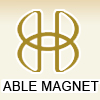Product (223)
- Permanent Magnets (24)
-
Neodymium Magnets
(83)

-
Ferrite Magnets
(19)

- AlNiCo Magnets (4)
- SmCo Magnets (4)
- Flexible Magnets (4)
- Speaker Magnets (6)
- Magnetic Products (21)
- Magnetic Assemblies (2)
- Wind Generator Magnets (1)
- Brushless Motor (48)
- Servo Motor (5)
- Others (2)
Equipments (8)
News (29)
FAQ (30)
Uses for Neodymium Magnets (2)
Neodymium Magnet Information (1)
Neodymium Magnet Safety (1)
Neodymium Magnet Physical Properties (1)
Magnet Glossary (1)
Quality Control (1)
Credit Report
Products Index
Company Info
Ningbo Able Magnetic Co., Ltd. [China (Mainland)]
Business Type:Manufacturer, Trading Company
City: Ningbo
Province/State: Zhejiang
Country/Region: China (Mainland)
News
New materials out of magnetic nanocellulose
Professor Olli Ikkala of the Department of Applied Physics in Aalto University School of Science and Technology (Finland) is a partner in an international research consortium that has generated novel types of magnetic materials.
The recent issue of the renowned publication Nature Nanotechnology contains an article "Making flexible Magnetic Material aerogels and stiff magnetic nanopaper using cellulose nanofibrils as templates" by a Swedish-Spanish-Finnish research consortium. It shows that a combination of cellulose nanofibers and magnetic nanoparticles allows, on the other hand, ultra-flexible porous magnetic materials and, on the other hand, mechanically strong magnetic nanopaper.
- The cellulose nanofibers have recently brought materials scientists and paper engineers together to develop novel applications and new functional materials, Ikkala describes the growing cooperation in the field.
- Nanocellulose can be disintegrated from plant cell walls or prepared bacterially. In this work we have used the latter concept but for larger scale the previous method is more suitable.
Bacterial nanocellulose combined with magnetic nanoparticles produces highly porous magnetic aerogels which are extremely flexible, and whose shape can be magnetically controlled both in the dried and wet state. This external malleability and porosity is useful for novel devices.
- The same type of nanocellulose is, in fact, the ingredient in the traditional Asian dessert nata de coco. So the material is completely safe, Ikkala affirms.
The combination of nanocellulose and magnetic nanoparticles can also be compressed using papermaking processes to form magnetic nanopaper. This process allows the packing of a very high-weight fraction of nanoparticles into solid materials.
- In fact, there is a growing need for developing facile concepts for packing a high-weight fraction of magnetic nanoparticles in three-dimensional structures. The present concept opens a new and an agile way for producing such materials, Ikkala explains.
Pre Page:
Germany working on rare earth...
Next Page:
Magnetic Products: The Choice Is Yours...
.gif)


